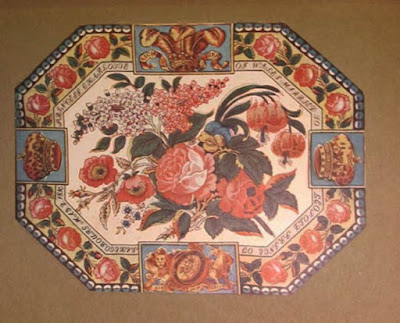Leopold and Charlotte
Alex Jennings doing a pretty darn good job of looking like
Albert's Uncle Leopold, the King of the Belgians in a
similar toupee.
He's playing it a bit diabolically for my taste, though.
I've always had a soft spot for Uncle Leopold. He
seems to have had his niece Victoria's and nephew Albert's
best interests at heart when he played matchmaker
and tutor to both.
Wedding of Prince Leopold of Saxe-Coburg &
Princess Charlotte of England
1816
Commemorative jug for the 1816 wedding
He was a handsome young man.
"I marry the best of all I have seen and that is some satisfaction,"
wrote his fiancee who had broken one engagement.
As cute as Lord M., don't you think?
Well, you don't read this to hear me go on about television hunks at Windsor Castle. It's about quilts and fabric. And Uncle Leopold made it into several quilts....
By way of this panel or commemorative medallion,
printed to celebrate the Charlotte/Leopold marriage.
In the inner border:
"Princess Charlotte of Wales Married
to Leopold Prince of Saxe Cobourg May 2, 1816"
Center of a cut-out chintz medallion in the collection
of the New England Quilt Museum.
Pheasants and Portuguese stripes in the border.
This looks quilted with no batting.
The panel was printed as yardage as in this piece from
the collection of the Victoria & Albert Museum.
The name of the printer on the tax stamp is
John Lowe and Co. Furniture Printers, Shepley Hall.
I recently found a photo of a medallion floating around on the internet:
Four royal wedding panels with palm trees and pheasants
And peacocks.
Here's one that looks quite British, sold at Tennant's Auctions last year.
Hearts are a nice addition.
Another one with hearts, mostly pieced, sold ten years
ago at Christies in London.
http://www.radiotimes.com/news/2018-01-26/was-prince-albert-really-the-illegitimate-son-of-prince-leopold/
More about Princess Charlotte at my blog post here:
http://austenfamilyalbumquilt.blogspot.com/2014/11/block-34-queen-charlottes-crown-for.html
And more about commemorative panels here:
http://quilt1812warandpiecing.blogspot.com/2012/04/british-commemorative-panels.html




















































